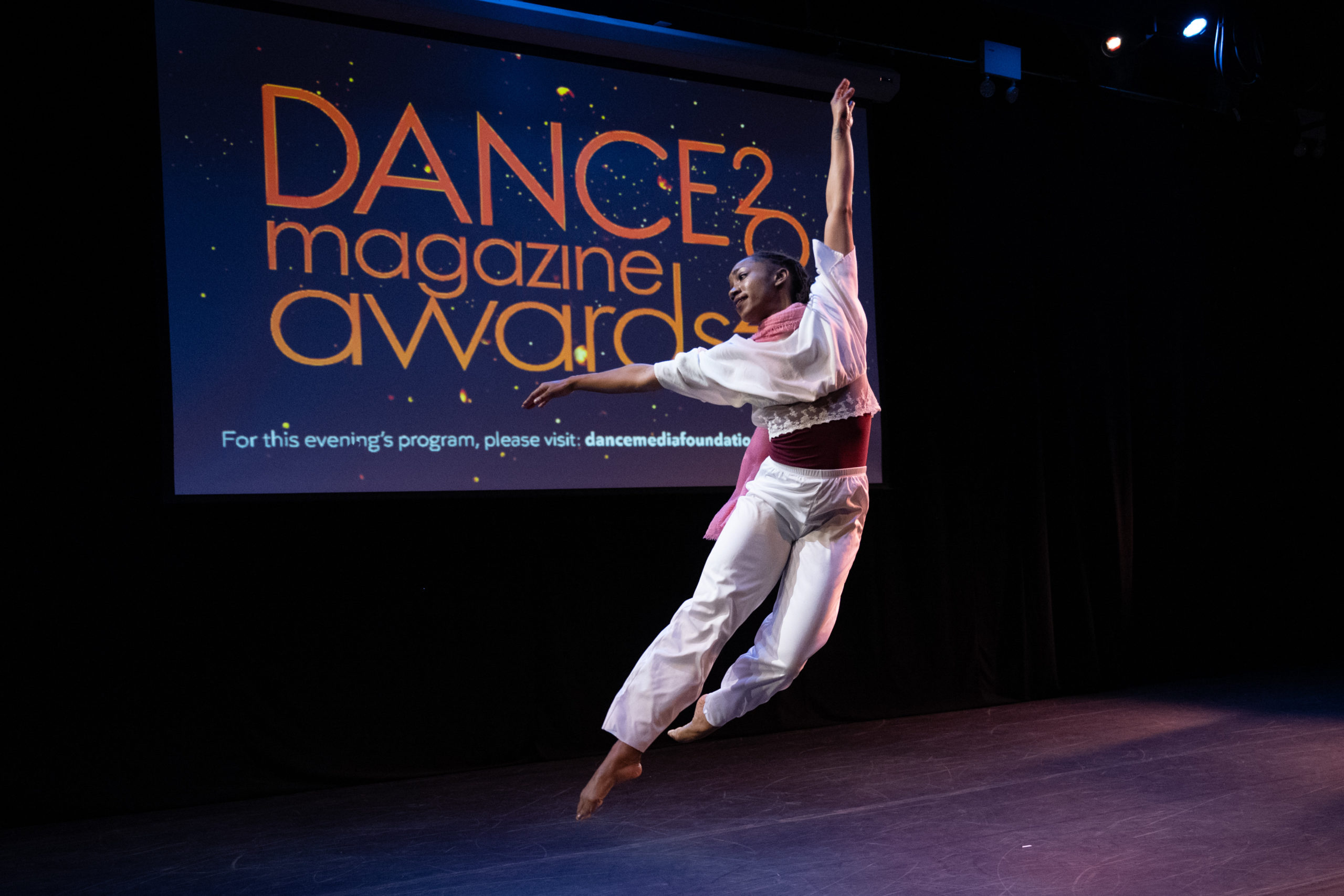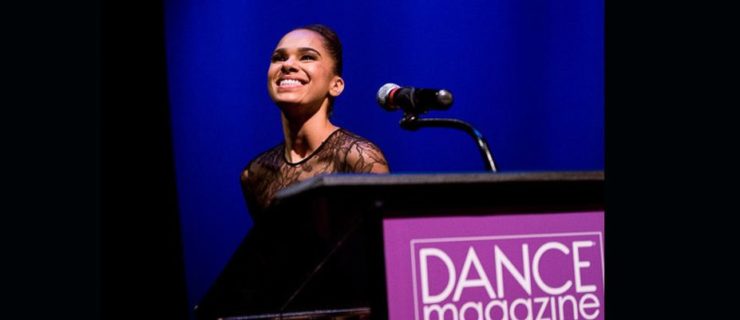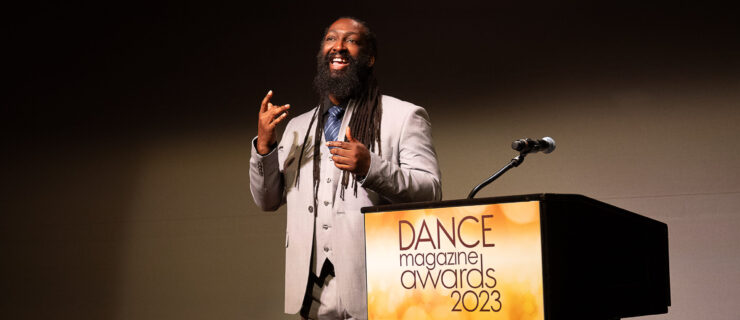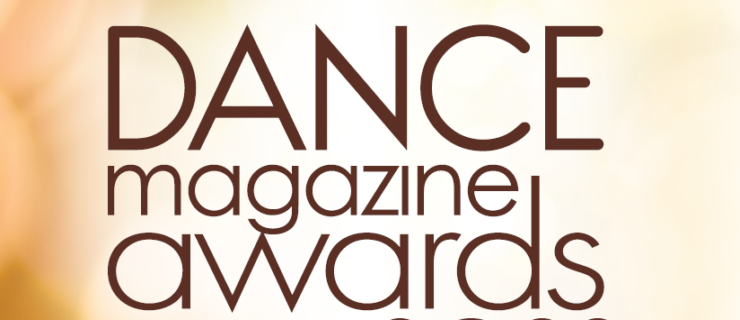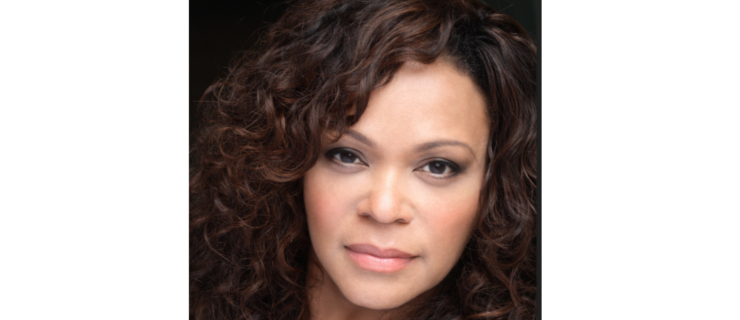The 2022 Dance Magazine Awards Celebrated Longevity and Interconnectedness
If there is one thing the 2022 Dance Magazine Awards ceremony made clear, it is how misleading the term “dance lineage” can be. Rather than traveling in a straight line, the connections and community that make our field what it is, that form each individual artist, are more like an intricate spider’s web, a many-branched tree full of unexpected intersections. And as each presentation at the event illustrated, the learning and inspiration flows not just from the older, more experienced artist to the younger, but in all directions.
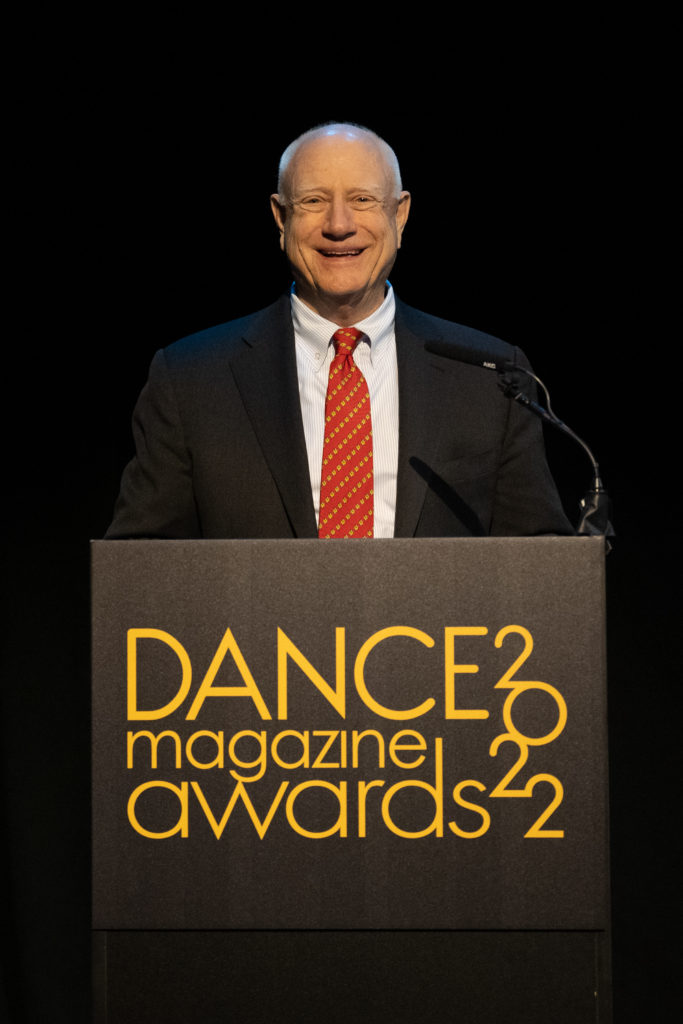
This year’s event was held at Chelsea Factory, where the first choreographic offering of the evening—Andrea Miller’s liquid, interconnected Pearls, performed by Harrison Ball and Patricia Delgado—was created. It was a particularly fitting tribute to Chairman’s Award recipient Jim Herbert, who not only founded Chelsea Factory but also, as Joyce Theater executive director Linda Shelton noted in her presentation, had recommended the song (“Pearls” by Sade) to Miller, one of the many dance artists he has supported and championed through his role as founder and executive chairman of First Republic Bank. “I asked, did she have a budget?” Herbert joked about meeting Miller for the first time 15 years ago, shortly after she founded Gallim. “She pulled out two little receipts. It worked out well.” In his speech, Herbert reminisced about not knowing what ballet was until 1966, when one of his colleagues invited him to attend a performance: “I fell in love that night,” he said, and his support for New York City’s varied dance scene has been unwavering since.
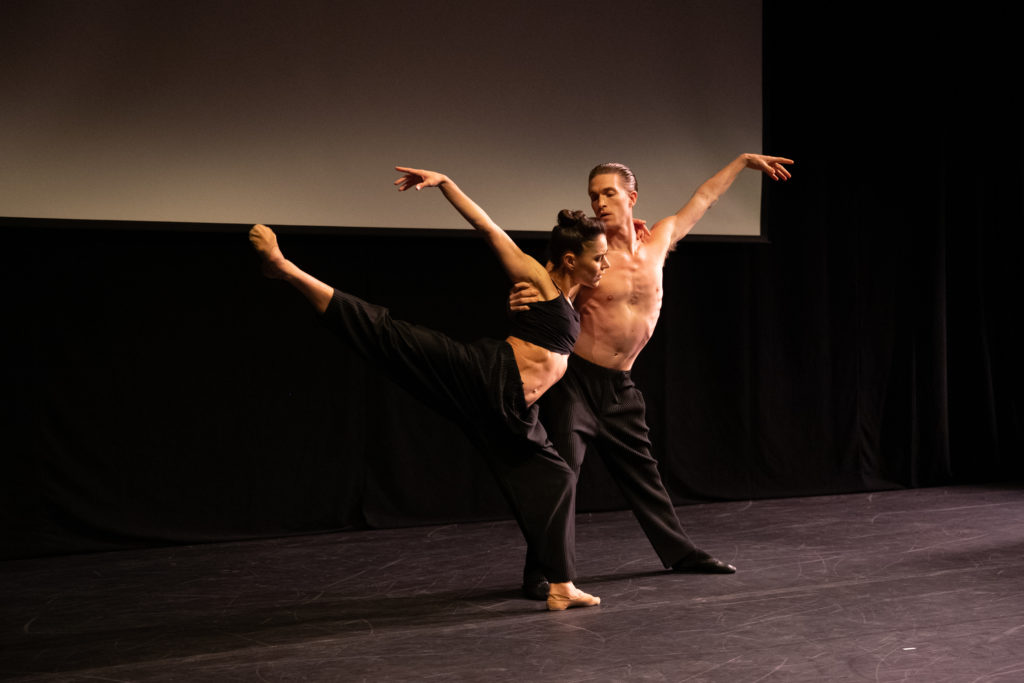
The theme of supporting nascent choreographic talent carried over into the presentation of this year’s Harkness Promise Awards, which grant two choreographers in their first decade of work $5,000 unrestricted grants and 40 hours of rehearsal space without expectation of a final product, funded by the net proceeds from the Dance Magazine Awards. Raja Feather Kelly, one of the inaugural recipients back in 2018, introduced Harkness Foundation for Dance executive director Joan Finkelstein, quipping, “You do have incredible taste.” Of the 2022 recipients, Kayla Farrish and Johnnie Cruise Mercer, Kelly said, “I cannot wait to be in community with you and see what you do.” Finkelstein also reflected on the last five years of Promise Award recipients: “All of them are continuing to make stunning work that opens up our field to new modes of expression.” She presented Farrish and Mercer with their awards after a video showcasing excerpts of their choreographic work. “I want to see what’s possible,” Farrish said in voiceover—a sentiment that felt ripe with (yes) promise.
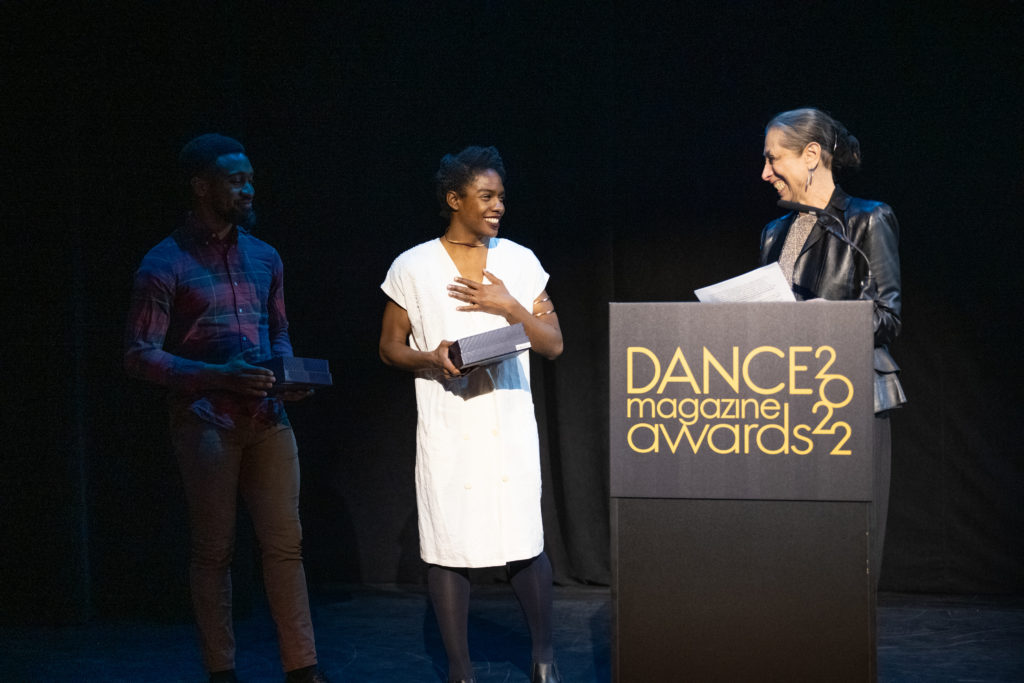
A filmed interview with Brenda Dixon-Gottschild (courtesy of PBS WHYY), interspersed with performance footage, showed the dance artist and scholar in every decade from her 20s to her 70s. “Here,” she concluded proudly after the video, “you see Brenda-Dixon Gottschild as an 80-year-old.” But first, Rennie Harris paid tribute to his “dance mother,” who he first met as a teenager. “There was something about the way you spoke that made me pay attention more than I would have to any other adult,” he said. “You inspired me to think critically about street dance—Black dance. Hers is not only the voice of her generation and my generation, but of generations to come. To quote Brenda, ‘I aim to perform corrective surgery on the historical record.’ Brenda Dixon-Gottschild, I am here to tell you your corrective surgery was successful.”
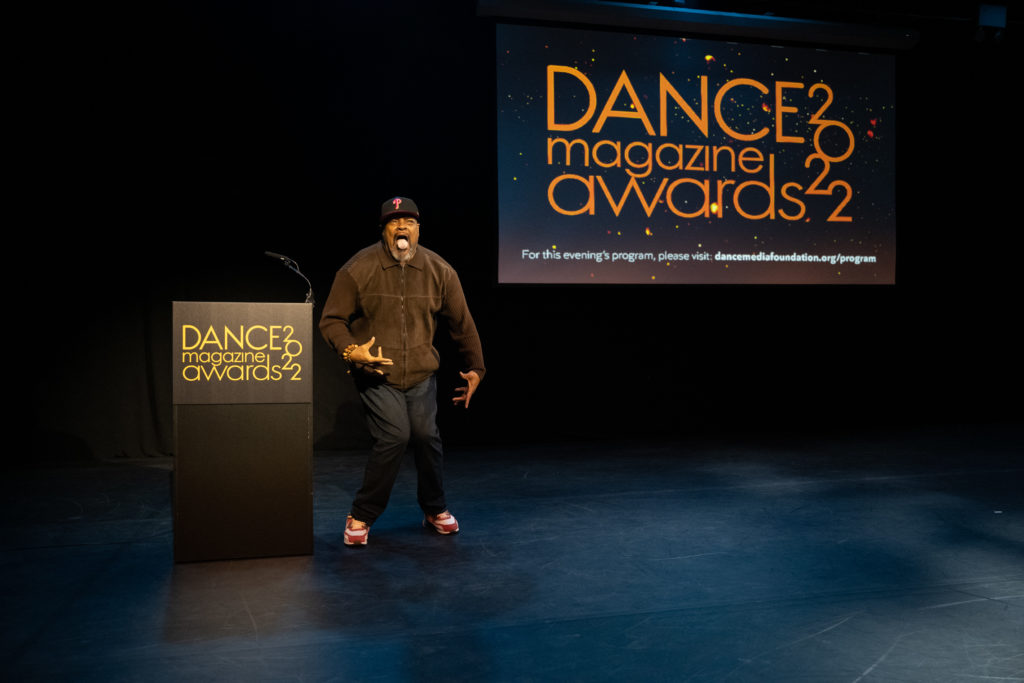
Harris proceeded to surprise the audience by dancing a brief solo with all his signature precision, cleverness and intention to a song he played from his phone—bringing down the house as he danced onstage for the first time in five years. In lieu of a more traditional acceptance speech, Dixon-Gottschild movingly performed a poem by Tracy K. Smith, “We Feel Now A Largeness Coming On,” with verve and gesture that was instinctively echoed by Harris (“my wonderful aesthetic son,” Dixon-Gottschild called him) as he stood listening beside her.
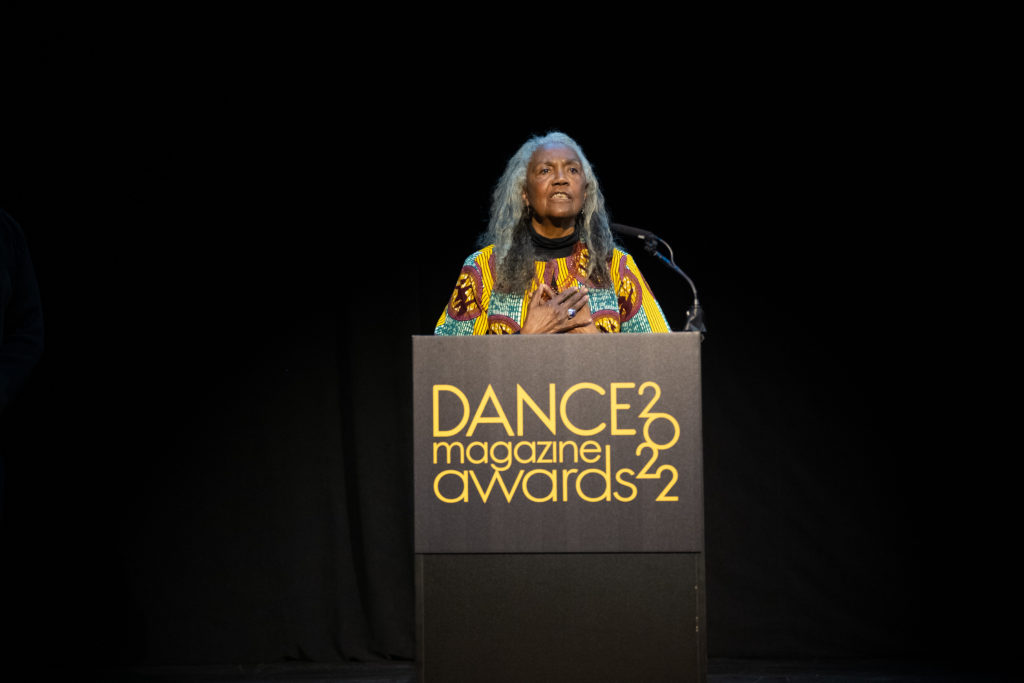
In paying tribute to ballet star Herman Cornejo, outgoing American Ballet Theatre artistic director Kevin McKenzie noted that one of the pleasures of directing the company has been getting to “witness great dancers before, during and after they discover what great dancing actually is,” as was the case with Cornejo, who proves that consistency is the secret to longevity. “If he was ever afraid of anything, I never knew it,” McKenzie said. “He would in essence walk out onto the edge of a cliff, hang his toes over and revel in the feel of the wind in his face. That’s what it felt like to watch him in his full glory. Now, to see him revisit roles 20 years later, it’s astonishing that he delivers them with the same clarity of his youth.”
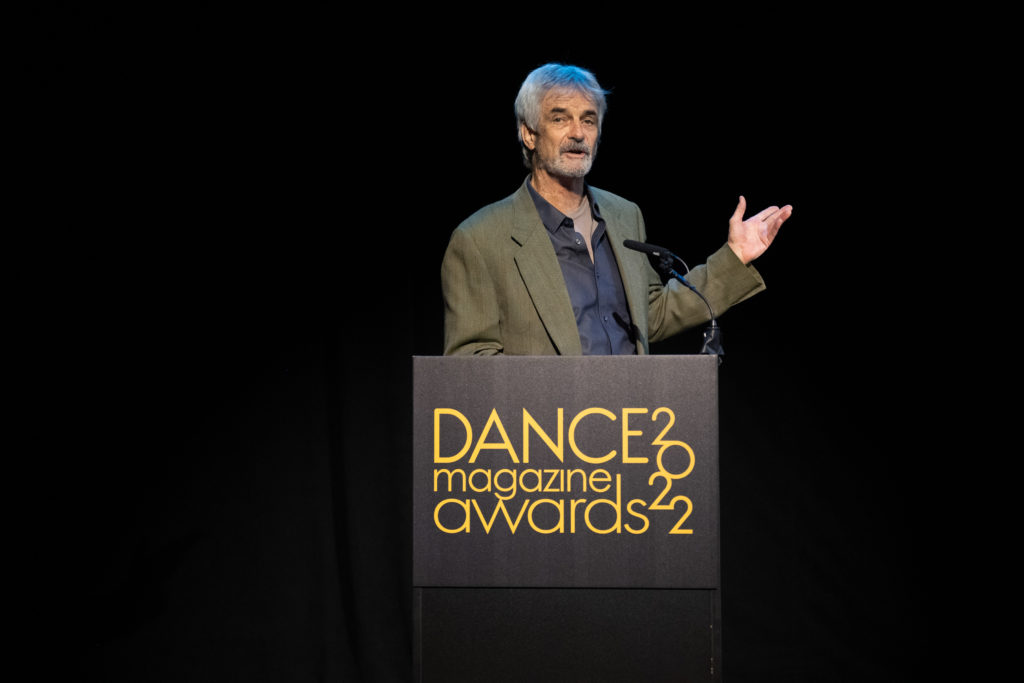
While Cornejo was unable to attend the ceremony, he delivered his acceptance speech in a pre-recorded video. “I’m not retiring anytime soon,” he reassured the audience with a smile, drawing laughter with the story of how he got his first contract with ABT: He was hired as an apprentice and was soon after cast in a soloist role in La Bayadère during the company’s tour to Japan; on the day of the performance, already in full makeup, he was informed by a union representative that “as an apprentice, I couldn’t do a principal role. So they brought a corps contract backstage for me to sign. So I did.” He concluded, “Nothing is impossible. Stay positive. Keep doing what you love to do.”
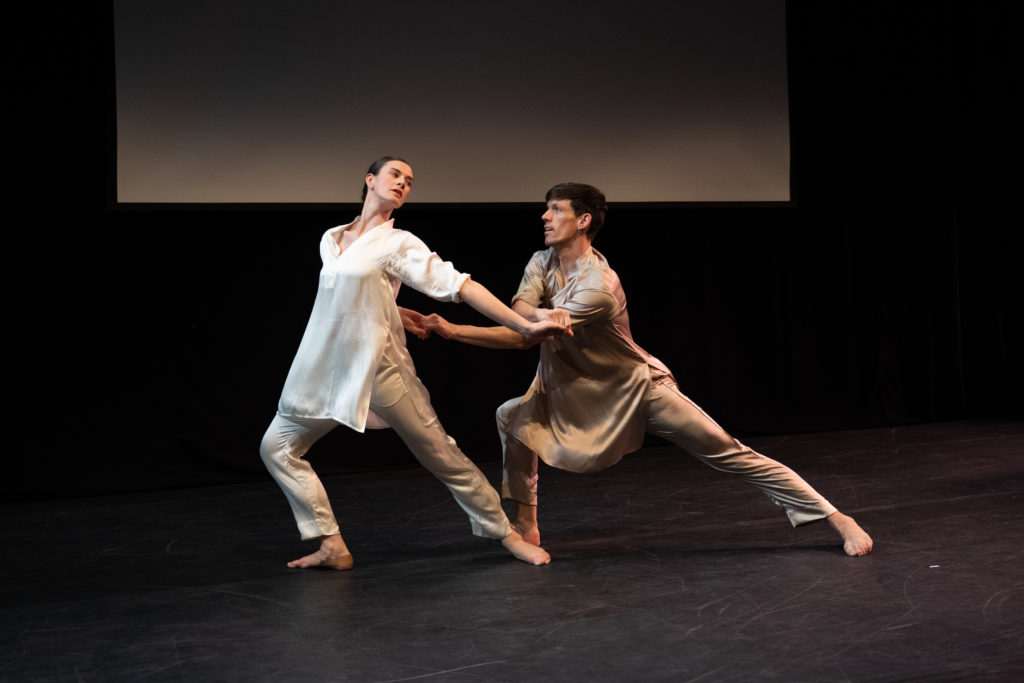
Kyle Gerry and Caitlin Scranton performed Lucinda Childs’ spare, luminous Étude 18, a work set to music by Philip Glass that just premiered in September—and which stood in stark contrast to Carnation, a solo of Childs’ from her Judson Dance Theater days, which Yvonne Rainer described in her presentation.
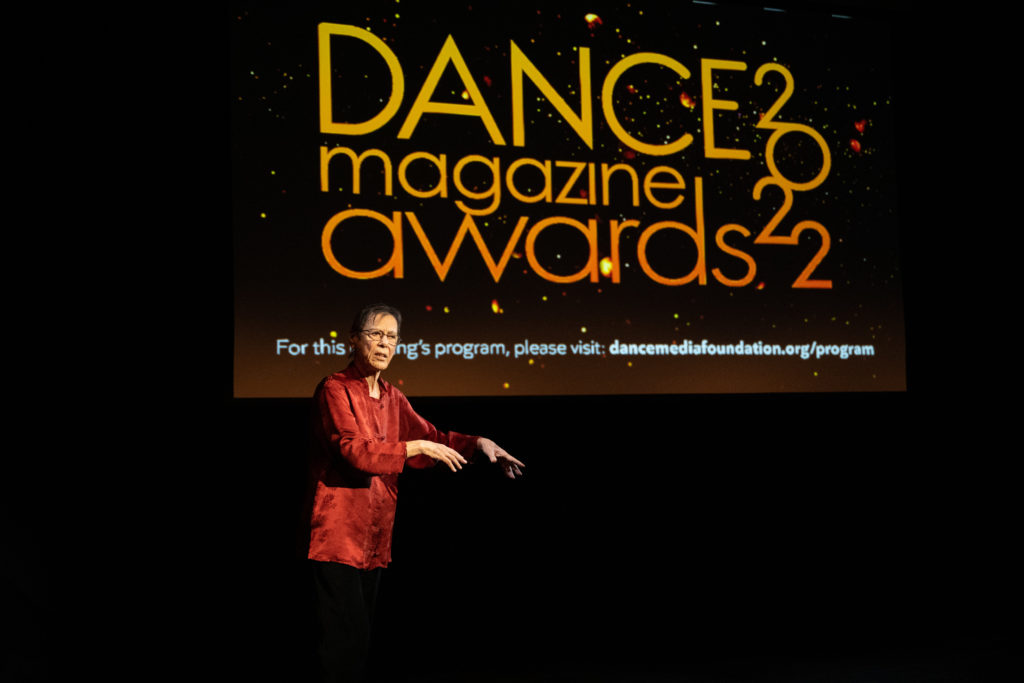
“This dance, I would say, is very exceptional in that it is not characteristic of anything she’s done since then,” Rainer said. She described Childs sitting at a table with one leg encased in a garbage bag and proceeding to put “a lettuce strainer upside down on her head, and already there’s an incredible drama and incongruity there because there is this utterly beautiful woman who is about to do some very ridiculous things.” Rainer moved to and from the microphone to gesture and mark space as she continued to describe Childs using hair curlers and kitchen sponges to create a particular image, dumping the materials into the garbage bag, and doing a handstand to cause all of the objects to come tumbling out. “This dance blew me and others who saw it away, and she never did anything like it again,” Rainer concluded before welcoming Childs to the stage to receive the “heavy object” that was her Dance Magazine Award.
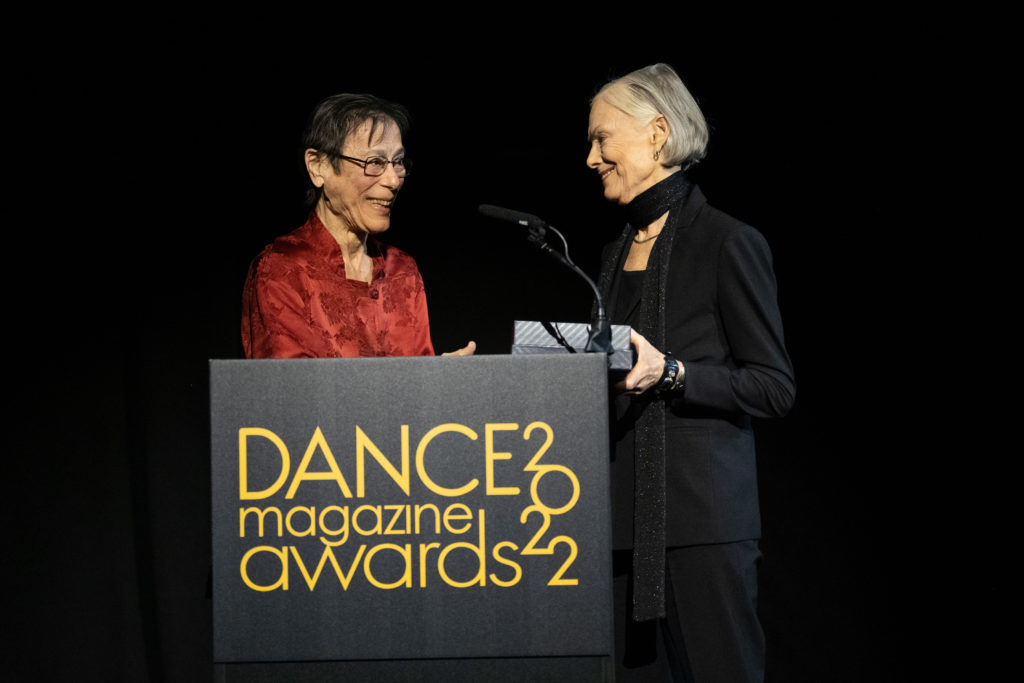
Childs, reflecting on meeting Rainer and following her to Judson Dance Theater, said, “I thought it was so fantastic, but I thought it was especially fantastic to be invited by Yvonne. I think that the most important thing, then and now, has been the whole spirit of collaboration, that we work together, that we shared ideas.” After thanking her collaborators, presenters, supporters and dancers from over the years, she concluded, “Everything that makes this art form has to happen in the way it’s supposed to happen—in the way we learned at Judson: What you do with what you’re doing is just as is important as what you’re doing. So what we did with what we do, is what we did.”
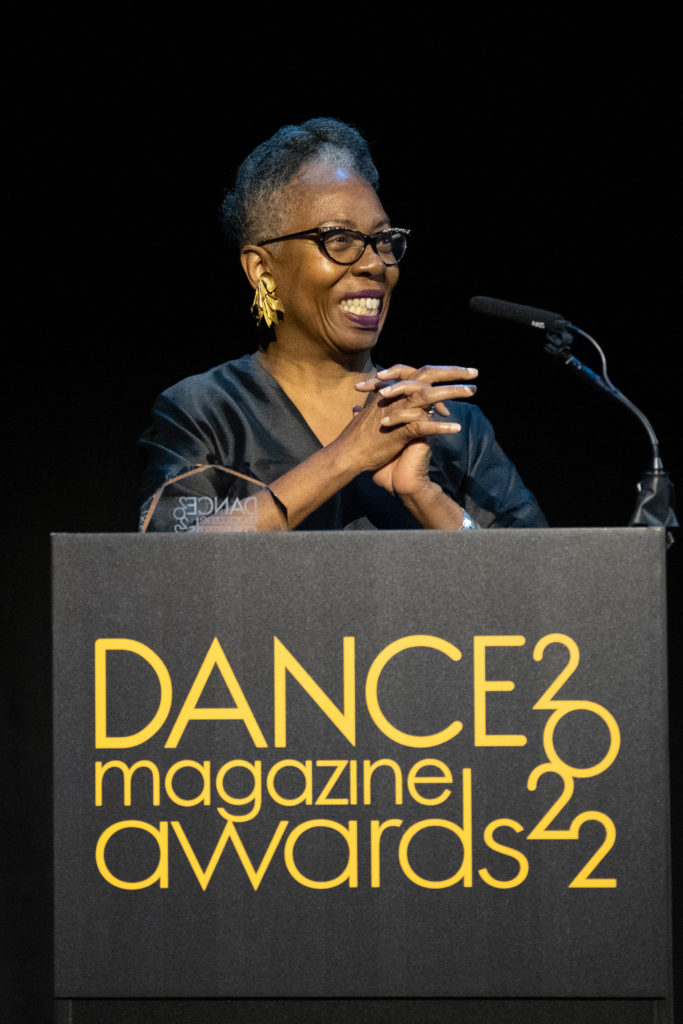
Dianne McIntyre’s tribute began with a performance of an excerpt from her Love Poems to God, a soulful and surprising duet for dancer Demetia Hopkins and singer Tina Fabrique, to poetry and music by Hannibal Lokumbe. The interconnectedness of the movement and music made the feedback Jawole Willa Jo Zollar recalled receiving from McIntyre as a young choreographer all the more vivid: “She said, You’re dancing to the music, now you gotta get inside the music,” Zollar recounted. “From there I knew I was gonna follow this woman.” She described the space McIntyre created for her Sounds in Motion company in Harlem as a place that “profoundly centered the community of Harlem and Black folks from all over,” which in the ’70s and ’80s was, “a free space for us Black folk where we could create without being concerned about the white gaze. All of these people whose names I had read about, or music I had listened to, were all there in the studio and passing through.” But McIntyre had done even more, and continues to do so; Zollar shared how McIntyre had recently shown a work in progress that Zollar’s students at Florida State University talked about through the end of the semester. “She continues to be an artist that is pushing, that is exploring, that is questioning, that is supporting and nurturing new generations of artists all across this country.”
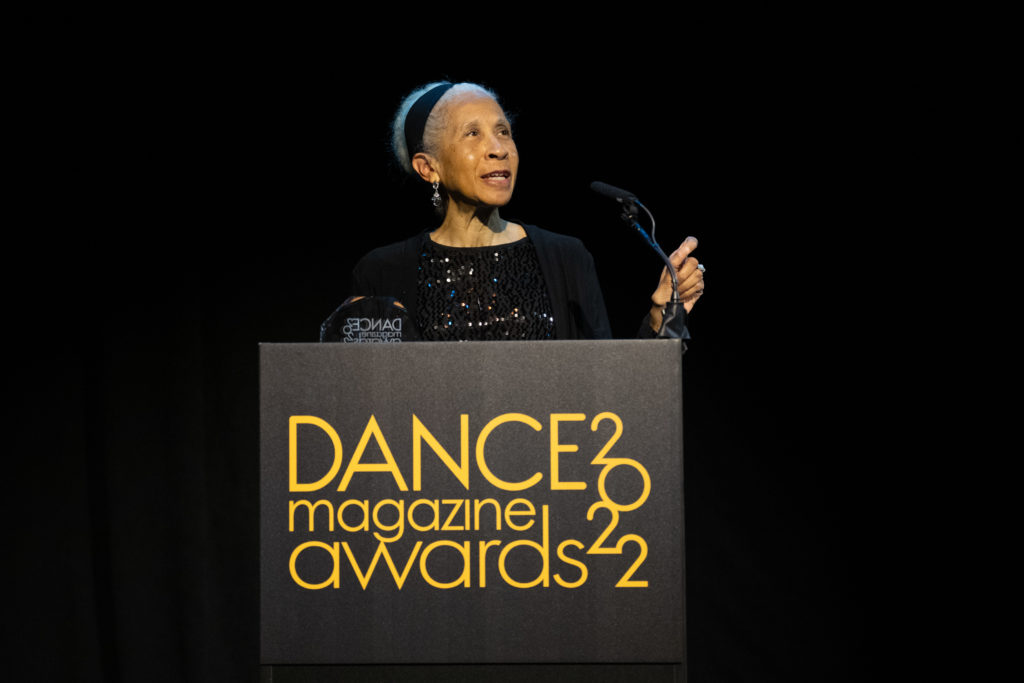
“My talk is mostly thank yous,” McIntyre admitted as she took the stage. Amidst her family (“My parents just said, ‘Go ahead, you wanna dance? Well…I don’t know…’ My mother said that, but my father said, ‘Yes! Whatever you want to do!’ “), mentors, collaborators and supporters, she made a particular point of saluting the dance writers who “didn’t put us in a box,” (among them Jennifer Dunning, Deborah Jowitt, Julinda Lewis, Sarah Kaufman and Wendy Perron) and her dance ancestors, particularly those who “did not have the fortune that I am having this evening: H.T. Chen, Eleo Pomare, Rod Rodgers, Viola Farber, Gregory Hines, Geoffrey Holder, Helen Tamiris, Jeff Duncan, Talley Beatty, Louis Johnson, Mary Hinkson, Baba Olatunji, Blondell Cummings, Pearl Primus, Charles Moore, Joan Miller, Billy Wilson, Louise Roberts, Janet Collins, Syvilla Fort…to name a few.” She concluded, “Now, I’ll soar even higher.”
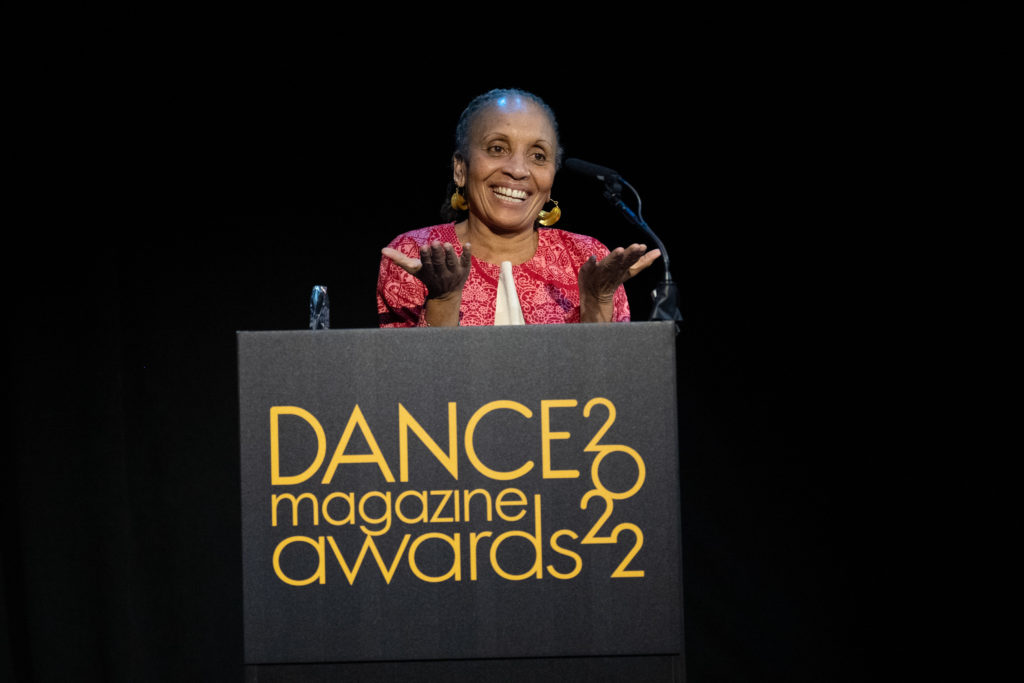
While Harrison Ball and Jonathan Fahoury performed a silken excerpt from Kyle Abraham’s Love Letter (on shuffle), the choreographer’s most recent entry in New York City Ballet’s repertory, presenter Charmaine Warren took us all the way back to her first encounter with Abraham: New York Theatre Workshop, 2006, in his solo Inventing Pookie Jenkins. Warren helped make introductions to Brad Learmonth and Ellen Dennis, which led Abraham to Harlem Stage’s E-Moves and the inaugural Fall For Dance festival, respectively; both, in messages that Warren shared on their behalf, were united in praising not only Abraham’s abilities as a performer and dancemaker, but also (and primarily) his humility and warmth. “Kyle will make time for you,” Warren said. “I promise you that.”
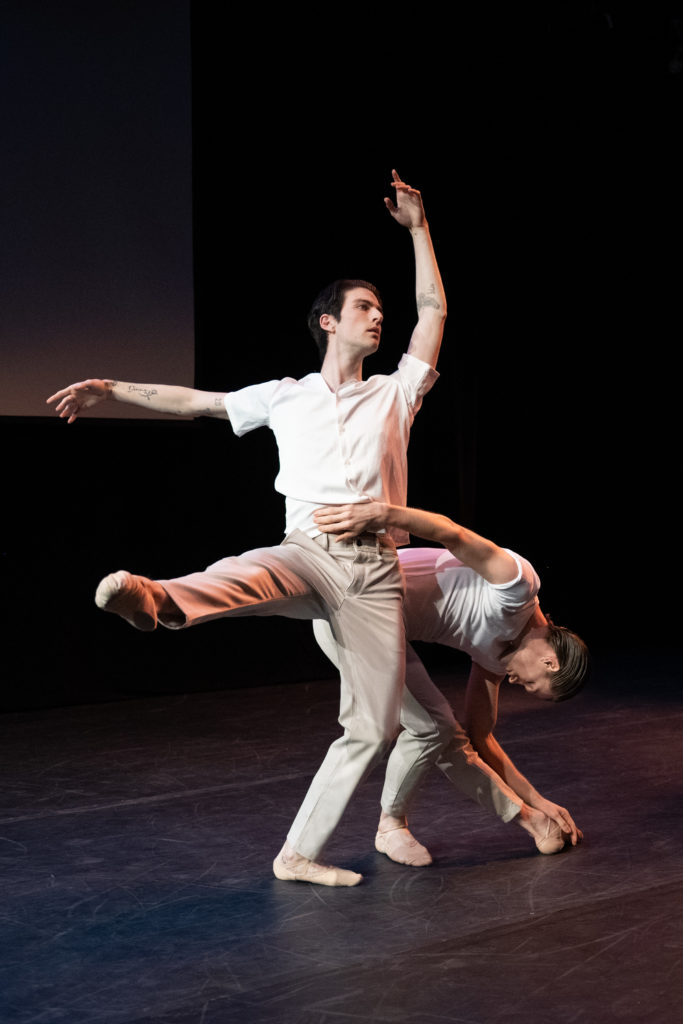
Those qualities were at the forefront as Abraham accepted his award, giving a speech that was primarily concerned with giving thanks: to the childhood friend who got him into the performing arts, to his teachers—in particular those “who when I couldn’t afford class, couldn’t afford to eat, couldn’t afford even transportation to get to class, who let me take their classes for free”—to the companies who have commissioned him or let him restage his works and to his A.I.M family, who he invited onto the stage, as “This is not an award that I could say that I should be receiving single-handedly.”
“I moved to New York summer of 1996,” Abraham reflected, “around the time that Ulysses Dove passed away. As someone who likes making work in both the ballet and contemporary worlds, and comes from a social dance background, I always wished that I could have a conversation with him. I still wish that to this day. I still wish I could have learned from him as I’ve tried to learn from his videos. I always wish I could say thank you to him.
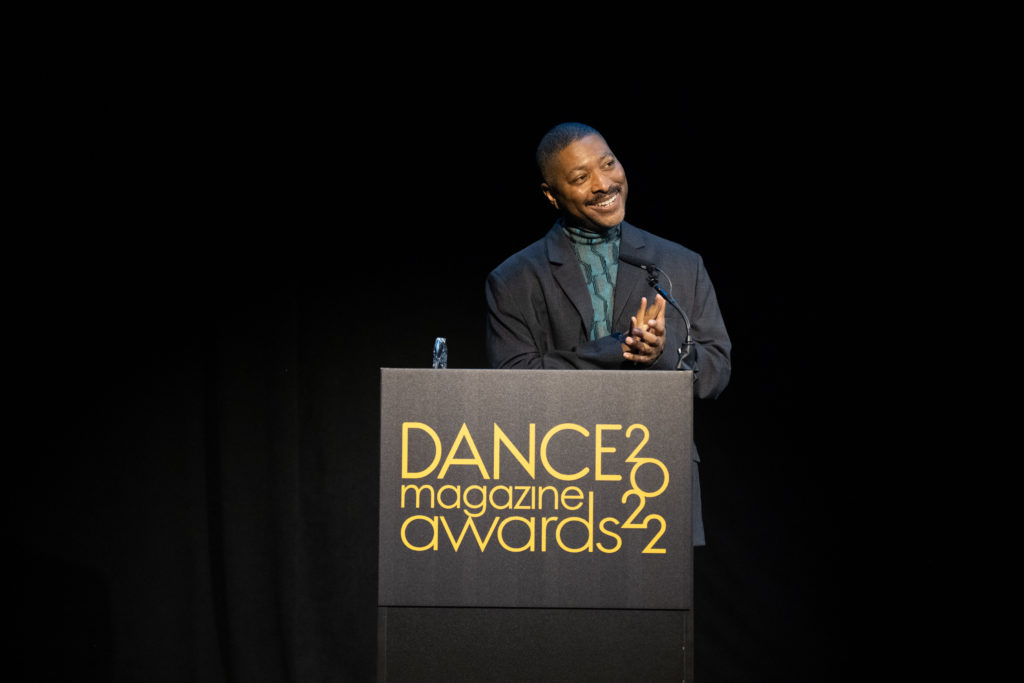
“We’ve lost so many artists over the years. I just want to make sure I can continue to acknowledge them and say thank you for the brilliance that you’ve created and shared with our entire world, and for inspiring me. I want to thank all the recipients tonight for all the brilliance and inspiration you’ve shared with all of us over the years.”
